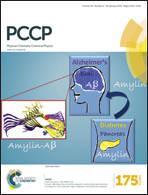An experimental and theoretical study of core–valence double ionisation of acetaldehyde (ethanal)
Abstract
Core–valence double ionisation spectra of acetaldehyde (ethanal) are presented at photon energies above the carbon and oxygen 1s ionisation edges, measured by a versatile multi-electron coincidence spectroscopy technique. We use this molecule as a testbed for analyzing core–valence spectra by means of quantum chemical calculations of transition energies. These theoretical approaches range from two simple models, one based on orbital energies corrected by core valence interaction and one based on the equivalent core approximation, to a systematic series of quantum chemical electronic structure methods of increasing sophistication. The two simple models are found to provide a fast orbital interpretation of the spectra, in particular in the low energy parts, while the coverage of the full spectrum is best fulfilled by correlated models. CASPT2 is the most sophisticated model applied, but considering precision as well as computational costs, the single and double excitation configuration interaction model seems to provide the best option to analyze core–valence double hole spectra.


 Please wait while we load your content...
Please wait while we load your content...